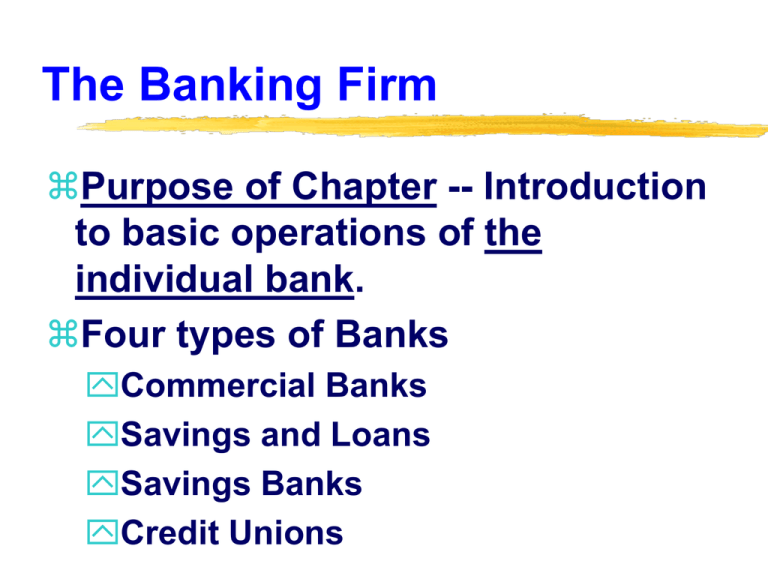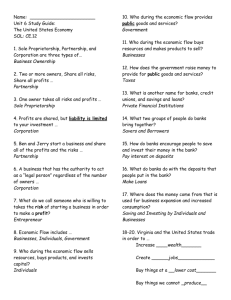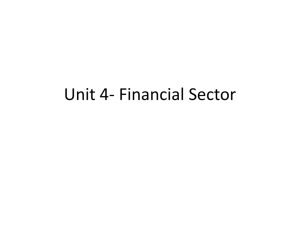The Banking Firm
advertisement

The Banking Firm Purpose of Chapter -- Introduction to basic operations of the individual bank. Four types of Banks Commercial Banks Savings and Loans Savings Banks Credit Unions The Bank’s Balance Sheet Assets Liabilities + Equity Assets -- Market value of items in your possession. Liabilities -- Amounts owed to other parties. Equity = Assets - Liabilities Working With Assets, Liabilities, and Equity Note: Definition of equity implies: Assets = Liabilities + Equity (Balance sheets balance!). A Balance Sheet Example Consider a house that you buy worth $120,000. You take out a mortgage of $100,000. Assets Liabilities + Equity House $120,000 Mortgage $100,000 Equity $20,000 The Bank’s Major Liabilities and Equity (1) Checkable Deposits (D) Includes Demand Deposits, Negotiable Order of Withdrawal (NOW) Acounts, Automatic Transfer of Savings (ATS) Accounts. Not a major source of funds for banks (2) Nontransactions Deposits (T) Includes Savings Deposits, and Small and Large Time Deposits (Negotiable CDs) Major source of funds for banks -higher interest rate (cost), but less frequency/more predictability of withdrawal (3) Borrowings (BORR) -- Funds borrowed by banks, usually to meet reserve requirements Eurodollars Repurchase Agreements Issued Federal Funds borrowed Discount Window Borrowings (4) Equity (or Equity Capital) (E) E = Total Assets - Total Liabilities Increases with bank profits, decreases with bank losses Equity-Asset Ratio = (Equity/Total Assets) -- measure of bank’s health The Bank’s Major Assets (1) Reserves (R) -- vault cash of banks plus deposits at the Federal Reserve Interest earning, but interest rate less than loan rates Purpose: to back up withdrawals from customer deposits How much reserves to hold? Profit versus safety Reserve Requirements: The “Minimum Safety Level” Federal Reserve: issues reserve ratios on checkable deposits (rD) and savings and time deposits (rT) with the provision that, at any time R > rDD + rTT Decomposition of Reserves Required Reserves (RR), RR = rDD + rTT Excess Reserves (ER), ER = R - RR Equivalent Ways to Express Reserve Requirement R RR, or ER 0 Other Assets (2) Cash items in the Process of Collection -- uncleared checks (3) Deposits at Other Banks (Correspondent Banking) (4) Securities Holdings (B) Holdings of Bonds, holding stock is not allowed Revenue source for banks Short-term bonds -- “secondary reserves” Holdings include Negotiable CDs of other banks Long-term bonds -- can enjoy conveniences of bonds (5) Loans Other major revenue source Less liquid than bonds. For the most part, the bank must hold them until maturity Higher default risk than bonds (5) Loans, Continued Preferred to bonds as a revenue source for banks. -- Inconveniences imply higher interest rate -- Personal aspect, tradition of banking (US). Distinction Between Types of Banks (Loans) Commercial Banks -- “Full Service Banks”, any type of loan Savings and Loans -- primarily consumer mortgages Savings Banks -- primarily consumer mortgages and consumer loans Credit Unions -- primarily consumer loans (different tax treatment as well) Fundamental Balance Sheet Rule Any customer withdrawal from any of their deposits (checkable deposits or savings and time deposits) must be met with an equal decrease in reserves. An Example: Customer Withdrawal Customer withdraws $200 from their savings deposit (T) at Chase Chase R - $200 T - $200 New Customer Deposits Example: Customer deposits $300 in their checkable deposit (D) Chase R + $300 D + $300 Banks as Financial Intermediaries Financial Intermediary -- An institution that borrows from lenders, then loans to borrowers. Takes advantage of institutional fact of life -- lenders want to “lend small”, but borrowers want to “borrow large”. An Example -- The Bank Increasing Its Profits You make a $1000 mortgage payment to Chase, $800 is interest and $200 is payment to principal. Interest paid on deposits: $300 to holders of savings and time deposits (T) and $50 to holders of checkable deposits (D). Balance Sheet Description Chase R + $1000 D + $50 L - $200 T + $300 E + $450 Bank Profit (E) = $800 - $350 = $450 A Banking Philosophy: Liability Management Liability Management -- Seek loan demand, then finance it by issuing CDs, or borrowing if under reserve requirements. Aggressive, profit-oriented policy, followed mainly by large banks. Liability Management: Evidence Negotiable CDs have become the primary source of bank funds. More bank borrowing (more outlets to borrow as well). Aggregate excess reserves are generally close to zero. Greater percentage of loans in asset portfolio (less liquid, more default risk than bonds). The Bank’s Nightmares Financial intermediaries have inherent fundamental instabilities. The bank can only reduce their probability of occurrence and the impact if they do occur. Bank regulation and regulatory agencies seek as well to reduce the probability of occurrence or reduce the impact to the bank when they happen (next chapter). Nightmare # 1 -Disintermediation Disintermediation -- The systematic withdrawal of customer funds, which can create a minor or major liquidity crisis. Adverse effect of minor case: bank slips below reserve requirement. The Bank Run: The Most Dramatic Case Consider the following balance sheet situation (rD = 0.10, rT = 0.05). Chase R $500 D $2000 L $6500 T $6000 Bonds $2000 E $1000 Customers want 50% of D and 50% of T (HELP!!). Ways to Reduce Adverse Effects: Disintermediation Seek sufficient liquidity in asset portfolio Increase excess reserves for anticipated unusual withdrawals Be competitive Use borrowing sources, when needed Nightmare #2 -Interest Rate Risk Interest Rate Risk -- Increases in interest rates (cost of funds) that the bank cannot pass on to its existing loans. Creates reduced profits or even losses on existing loans Most risky -- fixed rate mortgages (Savings and Loans!). Ways to Reduce Interest Rate Risk Reduce the gap in maturity between assets and liabilities -- Promote shorter term loans -- Promote longer-term deposits Seek other sources of income/profits (“off the balance sheet” banking) Nightmare #3 -Loan Default Loan Default -- Borrower fails to repay loan Declaring bankruptcy -- chapter 7 (consumers sell assets for discharge of debts), as opposed to chapter 13 (debtor arranges plan to repay debt). Most frequent for consumers – credit card balances (unsecured) Default on mortgages – secured loans, but could be a problem for banks if housing prices have fallen significantly. Example: Loan Default Consider the following balance sheet situation (rD = 0.10, rT = 0.05). Chase R $500 D $2000 L $6500 T $6000 Bonds $2000 E $1000 Equity-Asset Ratio = (1000/9000) = 11.1% The Balance Sheet After a Loan Default $500 loan default. Chase R $500 D $2000 L $6000 T $6000 Bonds $2000 E $500 Equity-Asset Ratio = (500/8500) = 5.6% Ways to Reduce Adverse Effects of Loan Default Screening/Collateral Knowing clientele Portfolio Diversification Seek to maintain sufficiently large equity-asset ratio A Preview of the Next Chapter Bank regulation – how regulatory agencies regulate the banking system. Wins and losses – US banking in the postwar period, with recent developments and current issues





